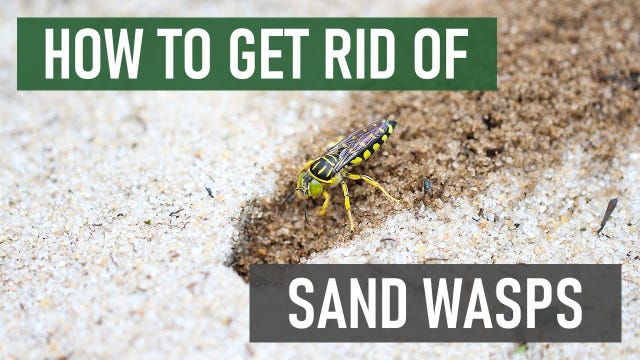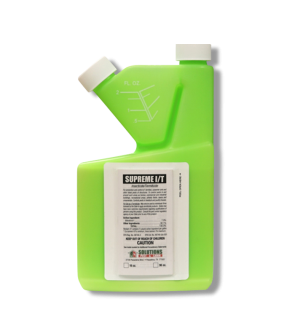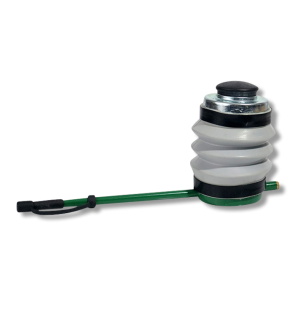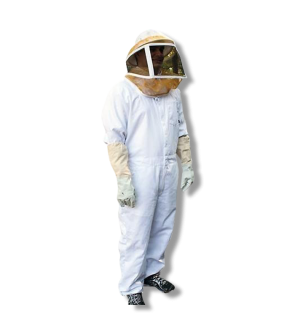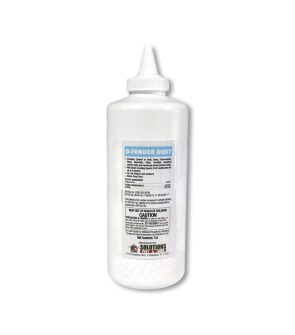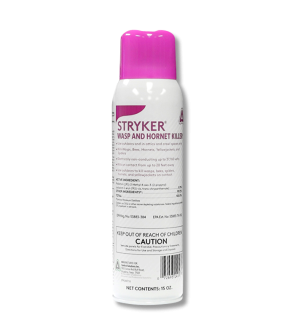Gain access to personalized product screening, the best pricing, rewards, and more!
Most Effective Products
Sand Wasp Control: How to Get Rid of Sand Wasps
This page is a general sand wasp control guide. Using the suggested products and methods will help you completely control sand wasps on your property. Follow this DIY guide and use the recommended products, and we guarantee 100% control of sand wasps.
Those dainty wasps that look like bees but burrow in sand and loose soil are called sand wasps. Like mud daubers, these wasps are beneficial pests that hunt other insects such as stink bugs, caterpillars, leaf-footed bugs, flies, and others to lay their eggs on and allow their larvae to ingest once hatched.
Sand wasps are a common species of solitary wasps composed of 20 genera but mainly belong to the genus Bembix. Though they are found mainly in sandy areas, they can be encountered by homeowners throughout the northern half of the United States. They are considered unaggressive pests, except when people or animals are too close to their burrows, leading to a painful sting.
Despite being a wasp, this pest does not live in colonies like other wasp species; instead, it is solitary. However, once the late spring and summer season approaches, this wasp species can increase its population and chances of stinging homeowners. For this reason, you will want to control sand wasps before their activities begin by following the recommended products and tips.
Identification
Before proceeding with treatment, you must ensure the pest infesting your yard is a sand wasp. Misidentification can lead you to use the wrong products and treatment approach, costing you time and money. Though there are 1,200 species of sand wasps in North America, there are bound to be some variances in their features, but they will share some distinguishing characteristics as listed below:

- Compared to other wasps, sand wasps have more stouter bodies that range between 0.8 to 1 inch in length. However, some species of sand wasps can grow up to 2 inches.
- Depending on the species, sand wasps are either yellow and black or white and black with greenish-yellowish beelike bands on their tubular abdomen.
- Their wings are transparent with brown veins.
- They have compound green eyes, close-set antennae, and yellow legs.
Use the image and description above to help you know what sand wasps look like for proper identification. If unsure, contact us by phone, with a photo of your pest through email, or visit one of our store locations where one of our team members can assist with identification and suggest the appropriate treatment plan.
Inspection
Once sand wasps have been confirmed in your yard, you can proceed with the inspection. During this process, you will determine where sand wasps are found on your property and the conditions allowing them to thrive. By learning this information, you can determine where to focus your pesticide applications, helping to increase sand wasp control.

Where to Inspect
Sand wasps are solitary hunting wasps that build their nests in sandy or loose soil areas in the ground, normally in dry environments. These areas can be seen in gardens, lawns, playgrounds, sandboxes in yards, volleyball courts with dirt or sand, and other areas that are bare or have little vegetation.
Adult sand wasps fly no higher than 3 feet from the ground. These wasps are active during the day, and you may see the adults actively hunting or feeding on pollen and nectar from nearby flowers.
What to Look For
Female sand wasps dig nests in the ground to store their collected prey and then lay their eggs upon them for the larvae to feed upon. The nests are burrows with an enlarged chamber at the bottom stocked with various or specific insects, depending on the species of sand wasp.
Sand wasps most commonly hunt flies, but they can also attack other insects, such as mosquitoes, grasshoppers, beetles, stink bugs, caterpillars, and leaf-footed bugs.
While they are not social wasps, several sand wasps may establish themselves near each other within the same vicinity.
Often, sand wasps will hover very close to people in pursuit of flies, which can cause homeowners to mistake them for an act of aggression.
Treatment
With any stinging pests, you will want to wear the proper personal protective equipment (PPE) or a professional bee suit for complete protection against sand wasp stings.
Sand wasp control is best done at the beginning of the spring season by dusting the burrow entrances with D-Fender Dust, then spraying any escaping wasps with Stryker Wasp and Hornet Killer, and lastly, applying Supreme IT as a barrier and ornamental treatment.
Since sand wasps are most active during the day, performing these treatments in the evening when they are less active and have returned to the nest is best.
Step 1: Dust Burrow Entrances
Treat all wasp nests on the ground with D-Fender Dust to kill sand wasps traveling to and from the nest. D-Fender Dust is a dry, moisture-resistant insecticide dust made with 0.05% deltamethrin that will control sand wasps for up to 8 months after application.
To use D-Fender Dust, you will need a handheld duster with a long, narrow extension tube, like the Pro Blow Handheld Pesticide Duster, to treat sand wasp nest entrances from a safe distance.
Apply 0.5 lbs. of D-Fender Dust per 1,000 sq. ft. of treatment area.
Fill the duster halfway with D-Fender Dust and leave plenty of room, as the duster needs enough space for the dust to mix with the air inside for even application. Ensure the cap is closed, then turn the Pro Blow Handheld Pesticide Duster upside down and shake to allow the D-Fender Dust to circulate within the duster.
Gently squeeze the Pro Blow Handheld Pesticide Duster until the wasp nest entrance and the area around the entrance are thoroughly coated with D-Fender Dust.
D-Fender Dust will treat pests that contact the product, eliminating them within 1 to 2 hours.
Check the treated sand wasp nest one or two days after treatment. Ensure all wasps are completely deceased before trying to destroy their nest. If pests are still active, then retreat to the nest.
Step 2: Eliminate Emerging Wasps
When possible, spray any sand wasps traveling throughout your property or emerging from their burrows with a wasp killer spray insecticide such as Stryker Wasp and Hornet Killer. This wasp-eliminating aerosol product contains 0.1% prallethrin, which is used to quickly knock down any wasps that make contact with the spray up to a safe distance of 20 feet.
While wearing gloves, shake the Stryker Wasp and Hornet Killer can then point towards sand wasps and their nests in an upright position. Stand from a safe distance of 6-15 ft. from the sand wasp nest, then spray until the product makes complete contact with the pest. When spraying sand wasps, ensure the wind is at your back and not blowing towards you.
This product may stain or darken asphalt surfaces and shingles, so be careful when treating sand wasps near these sites. If concerned, spray Stryker Wasp and Hornet Killer on a small, inconspicuous area.
Step 3: Spray Residual Insecticides
Once nest sites and the pests are treated, you will apply a residual insecticide to ornamentals and perform a barrier treatment to keep them away from your home. This application will also help to remove additional food sources for the adult sand wasp.
We recommend using Supreme IT, a residual insecticide formulated with 7.9% bifenthrin to eliminate wasps and 70 other types of pests upon contact. Once dried, this product's residual will leave no offensive odors and continue to repel and kill wasps for up to 90 days.
This suspended concentrate product must be mixed with water before being applied, which can be done with a handheld pump sprayer.
Determine how much Supreme IT to use by measuring the square footage of the treatment area. Measure the length and width of the treatment area in feet, then multiply them together (length X width = square footage).
Apply 0.25 to 0.5 fl. oz. of Supreme IT per gallon of water per 1,000 sq. ft. of ornamentals. For a perimeter application, use 1 fl. oz. of product per gallon of water per 1,000 sq. ft.
To mix, fill your handheld pump sprayer with half the water, add a measured amount of Supreme IT, and pour the remaining water into the spray tank. Close the spray tank lid and shake until the solution is evenly mixed.
Apply the mixed solution as a perimeter treatment around the exterior of your home's foundation. Spray 3 feet up the structure and 3 feet out on the ground. While sand wasps will not come into homes, you will want to spray entry points to prevent other insects from coming inside. By treating entry points, you also help reduce harborages for prey insects the sand wasps depend on for food. Spray around entryways, window and door frames, garage doors, and cracks and crevices.
Since adult sand wasps feed on nectar from ornamentals, you must spray any ornamental trees, shrubs, and plants in your yard. Spray above and beneath the plant leaves, and spray to the point of wet, but not runoff. If wasp activity continues, wait until 7 days after the last application.
Before applying the solution to the entire planting, test treat a small number of plants and watch for signs of sensitivity. Some plant species may be sensitive to the final spray solution.
Allow the product to dry completely before letting anyone around the treatment area.
Prevention
When sand wasps are no longer on your property, you must follow some preventative practices to ensure they do not return. Listed below are recommended practices to follow to ensure sand wasps do not return to your yard:
- Frequently raking over your lawn and near nest areas can cause sand wasps to relocate to a less frequently disturbed property.
- Cover the nest area with a tarp for several days to discourage sand wasps from that part of the yard and cause them to abandon their nests.
- Sand wasps prefer bare and loose dirt areas with little plant life. Consider growing or placing shrubs, flowers, or other ornamentals to thicken vegetation and minimize exposed soil. Additionally, bare and exposed soil areas on your lawn can be treated with a seasonal fertilizer to thicken turf growth and repel these pests.
- Add about 6 inches of soil to the top layer of ground, but do not mix it in, as this will only loosen the dirt more and increase habitats for sand wasps.
- To keep sand wasps away, apply Supreme IT quarterly to the perimeter of your home and ornamentals. Then, treat any new burrows with D-Fender Dust the moment they appear within your property to control future generations of sand wasps.
Key Takeaways
What are Sand Wasps?
- Sand wasps are solitary hunting wasps that build their nests in the ground, usually in sandy or loose dirt areas. As predatory wasps, they sting other insects and then take the paralyzed pest back to the burrow for the female sand wasp to lay her eggs on. After the egg hatches, the sand wasp larvae feed on the paralyzed insect.
How to Get Rid of Sand Wasps
- To get rid of sand wasps from your yard, you must first dust their nest entrances with D-Fender Dust to eliminate wasps as they leave and enter the nest. Next, you will directly treat any visible sand wasps with Stryker Wasp and Hornet Killer. Lastly, treat ornamentals in your property and the perimeter of your home with a repellent insecticide like Supreme IT.
Preventing Sand Wasp Reinfestation
- Prevent sand wasps from returning to or visiting your yard in the future by applying regular fertilizer, installing thick vegetation such as ornamentals, replacing the top layer of soil on your ground, and applying Supreme IT every 90 days.






